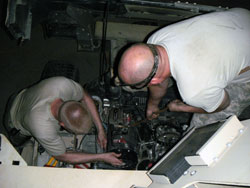Keeping the Minnesota Guard's Red Bulls moving
1st Brigade Combat Team, 34th Red Bull Infantry Division report

Army Sgt. Roger Viker of Charlie Company, 2nd Battalion, 135th Infantry Regiment, uses an improvised lever made from rebar to lift a generator into place. Army Staff Sgt. Bryan Haley, a wheeled vehicle mechanic in Bravo Company, 2nd Bn. 135th Infantry Regiment helps guide it into place. (Courtesy photo) (Released)
 download
hi-res photo
download
hi-res photoKUWAIT (8/26/11) - Everyone sees the pictures of Soldiers on patrol in Army vehicles, but few people ever see the maintenance it takes to get the vehicles on the road.
The maintenance section attached to Headquarters and Headquarters Company, 2nd Battalion, 135th Infantry Regiment is the cog that keeps the wheels turning in Kuwait for the rest of the battalion.
Ten soldiers divided in three shifts have the job of keeping the vehicles for a battalion ready to go at a moment’s notice and to fix any problems that come up from driving in a harsh desert environment.
The heat affects more than the vehicles. Most of the routine maintenance is done at night due to the heat. Army Staff Sgt. Bryan Haley, a wheeled vehicle mechanic, describes the routine.
“Our first shift focuses on the admin side of maintenance with the dispatches and turn in of vehicles, along with reminding units which vehicles are due for services,” Haley explained.
“Second shift usually brings in the vehicles, gets everything set up and then starts on the basic maintenance after it cools down. This allows the third shift to spend their time turning wrenches in the cooler weather,” Haley said.
The maintenance section has adapted to more than the weather. Army Sgt. 1st Class Richard Linskey, the maintenance section noncommissioned officer, said “[i]t’s been a good experience because we’ve been able to work with MRAP’s and other vehicles that we don’t have back home.”
“Since we’ve spent most of the past two years training up on general Soldier tasks we fell behind a bit on doing our actual MOS [military occupational specialty] of vehicle maintenance,” Linskey noted.
National Guard units have to spend a lot of the drills and two-week annual training time prior to a deployment proving to the regular Army that they can defend themselves and attack an enemy along with doing their Army jobs.
Some Soldiers have to expand their horizons even after their pre-deployment training due to the military’s heavy use of civilian contractors. Army Spc. Michael Dougherty’s experience is one example.
“My MOS is being a generator mechanic, but the civilians do that where we are, so I had to train on new tasks to make me feel more like part of the team,” Dougherty said.
Dougherty said, “I’ve been the TAMMS [The Army Maintenance Management System] operator because I got to go through Train the Trainer at Fort McCoy, Wisc. and got help from Sgt. 1st Class Linskey to get me up and running. Now I’m getting to use this in a real-world situation.”
Despite transitioning from the colder weather of Minnesota to the heat of the Kuwaiti desert and working with equipment that is new to them, the HHC 2-135 IN BN Maintenance section is revved up and running at top speed.
